Usage Note 22604: Marginal effect estimation for predictors in logistic and probit models
 |  |  |
The marginal effect of a predictor in a categorical response model estimates how much the probability of a response level changes as the predictor changes. For a continuous predictor, the marginal effect is defined as the partial derivative of the event probability with respect to the predictor of interest. For a binary categorical predictor, it is the change in event probability when the predictor is changed between its levels.
As a derivative, the marginal effect is the slope of a line drawn tangent to the fitted probability curve at the selected point. It is the instantaneous rate of change of the probability at that point. Note that the marginal effect depends on the predictor setting that corresponds to the selected point at which this tangent line is drawn, so the marginal effect of a variable is not constant. A measure of the overall effect of the predictor is the average of the marginal effects (AME). An alternative overall measure is marginal effect evaluated at the mean of all of the predictors (MEM). For small samples, the AME is considered the better measure.
Note that if the fitted probability curve is approximately linear (as it is near p=0.5) at the selected point, then the tangent line will closely approximate the fitted curve and the marginal effect will closely approximate the change in probability when changing the predictor by a fixed amount such as one unit. But in areas where the curve is nonlinear (near the smallest and largest values of p), the marginal effect might deviate substantially from the change over a fixed amount.
For a categorical predictor, the derivative is not strictly defined. In this case, the marginal effect is measured by the change in predicted probability between its levels.
For a binary logistic main-effects model, logit(p)=Σixiβi , the marginal effect of xi is equal to p(1–p)bi , where p is the event probability at the chosen setting of the predictors and bi is the parameter estimate for xi . The binary probit main-effects model is Φ-1(p)=Σixiβi , where Φ-1 is the inverse of the cumulative normal distribution function, or probit. The marginal effect of xi in the probit model is equal to φ(x'b)bi , where φ(x'b) is the density function of the standard normal distribution evaluated at x'b, x'b is the product of the row vector of chosen covariate values, x, and the column vector of parameter estimates, b, and bi is the parameter estimate for xi .
Marginal effects for continuous and categorical predictors in binary response models are available using the Margins macro. The Margins macro can also estimate and test predictive margins and marginal effects in other generalized linear models such as Poisson and gamma models and in Generalized Estimating Equations models. Additionally, point estimates of marginal effects for continuous predictors in binary or ordinal responses in main effects models are available in PROC QLIM in SAS/ETS® software by specifying the MARGINAL option in the OUTPUT statement.
Example: Binary logistic model
This example illustrates estimating marginal effects in a binary logistic model. In addition to the Margins macro and PROC QLIM, the partial derivative can be computed using results from the procedure used to fit the model. Note that many SAS® procedures can fit the binary logistic model as discussed in this note on the kinds of logistic models available in SAS. This example uses the cancer remission data presented in the example titled "Stepwise Logistic Regression and Predicted Values" in the PROC LOGISTIC documentation.
Marginal effects using the Margins macro
The following call of the Margins macro estimates the average marginal effect (AME) for the BLAST predictor. Note that the macro code must first be downloaded and submitted in your SAS session in order to make it available for use. The macro first fits a logistic model (the default when dist=binomial is specified) with response variable REMISS and predictors BLAST and SMEAR. The probability of REMISS=1 is chosen for modeling by roptions=event='1'. The macro then estimates the marginal effect of the continuous predictor specified in effect=. A confidence interval is requested with options=cl.
%Margins(data = Remiss,
response = remiss,
roptions = event='1',
model = blast smear,
dist = binomial,
effect = blast,
options = cl)
The average marginal effect of BLAST is estimated to be 0.315. A 95% large-sample confidence interval is also provided as well as a test that the marginal effect is zero. The macro can be run again to estimate the average marginal effect for SMEAR.
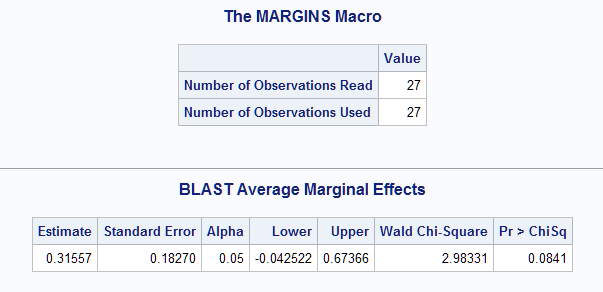 |
The average marginal effect at the means (MEM) of the predictors can be obtained by adding the atmeans option.
%Margins(data = Remiss,
response = remiss,
roptions = event='1',
model = blast smear,
dist = binomial,
effect = blast,
options = cl atmeans)
The mean values of the predictors are displayed first. The estimate of the marginal effect of BLAST at the means of BLAST and SMEAR is 0.353.
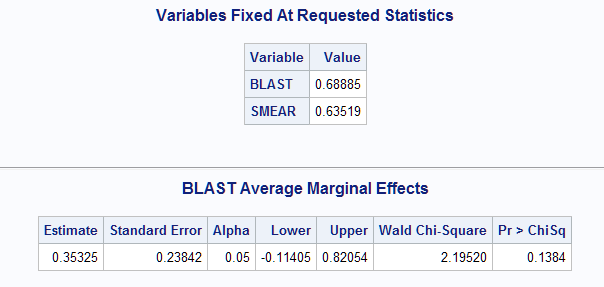 |
You can also estimate the marginal effect at one or more settings of the predictors by specifying one or more of at=, atdata=, atwhere=, or the statistics options (mean=, median=, q1=, q3=). For example, the following estimates the AME at the settings in the first observation of the Remiss data set for which BLAST=1.1 and SMEAR=0.83.
%Margins(data = Remiss,
response = remiss,
roptions = event='1',
model = blast smear,
dist = binomial,
effect = blast,
at = blast smear,
atwhere = blast=1.1 and smear=.83,
options = cl)
The marginal effect for BLAST at this setting is 0.405 which matches the result for the first observation using other methods as shown below.
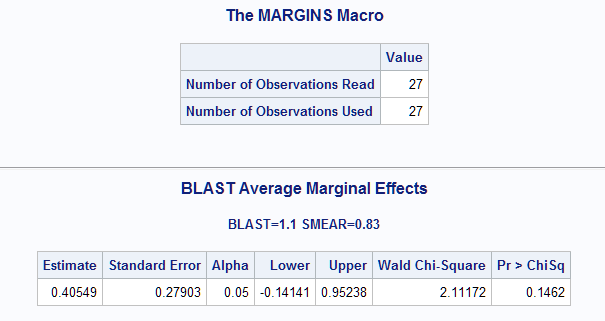 |
Marginal effects using PROC QLIM
The MARGINAL option in PROC QLIM should only be used to obtain point estimates of marginal effects for predictors not involved in interactions or higher-order effects in the model.
The following statements use PROC QLIM to fit the logistic model. The MARGINAL option in the OUTPUT statement provides marginal effects for both predictors. The OUTPUT statement creates a data set (OUTQLIM) containing a marginal effect estimate for each observation using the predictor values in that observation. PROC PRINT displays the first five observations of the OUT= data set and all marginal effects. PROC MEANS computes the average marginal effect.
proc qlim data=Remiss;
model remiss=blast smear / discrete(d=logistic);
output out=outqlim marginal;
run;
proc print data=outqlim (obs=5) noobs;
var smear blast meff:;
run;
proc means data=outqlim mean min max;
var Meff_P2:;
run;
The MARGINAL option provides the marginal effect on the probabilities of both response levels and for both predictors. So, variable Meff_P1_blast contains the marginal effects of BLAST on the first level of the response (REMISS=0). Meff_P2_blast contains the marginal effects of BLAST on the second level of the response (REMISS=1).
 |
The average marginal effect for BLAST on REMISS=1 is 0.315 as found by the Margins macro above. The minimum and maximum marginal effects are also provided.
 |
The same can be done for a probit model. In the Margins macro, specify link=probit. To fit the probit model in PROC QLIM, omit the D=LOGISTIC option from the previous code. The results (not shown) produce estimated marginal effects for BLAST similar to the values estimated under the logistic model.
%Margins(data = Remiss,
response = remiss,
roptions = event='1',
model = blast smear,
dist = binomial,
link = probit,
effect = blast,
options = cl)
proc qlim data=Remiss;
model remiss=blast smear / discrete;
output out=outqlim marginal;
run;
proc print data=outqlim (obs=5) noobs;
var smear blast meff:;
run;
proc means data=outqlim mean min max;
var Meff_P2:;
run;
Marginal effects using results from PROC LOGISTIC
As with PROC QLIM, the formulas used in the following are only appropriate for estimating point estimates of marginal effects for predictors not involved in interactions or higher-order effects in the model.
To compute the marginal effects using results from a model fit with PROC LOGISTIC, specify the OUTEST= option to save the parameter estimates in a data set. Also specify the P= option in the OUTPUT statement to save the predicted probabilities from the logistic model.
proc logistic data=Remiss
outest=logparms(rename=(blast=tblast smear=tsmear));
model remiss(event="1")=blast smear;
output out=outlog p=p;
run;
Then use a DATA step to combine the OUTEST= and OUTPUT OUT= data sets and compute the marginal effects for each observation in the original data. Only the marginal effects for the response level representing the event of interest (REMISS=1) are computed below. The marginal effects for REMISS=0 could be similarly computed. The first five marginal effects are displayed by PROC PRINT and the average, minimum and maximum marginal effect are displayed by PROC MEANS.
data outlog;
if _n_=1 then set logparms;
set outlog;
MEffBlast = p*(1-p)*tblast;
MEffSmear = p*(1-p)*tsmear;
run;
proc print data=outlog (obs=5) noobs;
var smear blast MEff:;
run;
proc means data=outlog mean min max;
var Meff:;
run;
Notice that the estimated marginal effects match the previous results from the Margins macro and PROC QLIM.
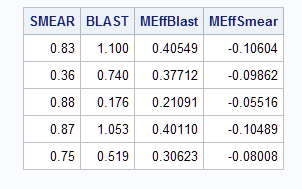  |
For the probit model, use the LINK=PROBIT option in PROC LOGISTIC (or use PROC PROBIT) to fit the model. Specify the XBETA= option in the OUTPUT statement to save the x'b values from the probit model. In a DATA step, combine the OUTEST= and OUTPUT OUT= data sets and use the PDF function to compute the marginal effects for the probit model.
proc logistic data=Remiss
outest=prbparms(rename=(blast=tblast smear=tsmear));
model remiss(event="1")=blast smear / link=probit tech=newton;
output out=outprb xbeta=xb;
run;
data outprb;
if _n_=1 then set prbparms;
set outprb;
MEffBlast = pdf('NORMAL',xb)*tblast;
MEffSmear = pdf('NORMAL',xb)*tsmear;
run;
proc print data=outprb (obs=5) noobs;
var smear blast MEff:;
run;
proc means data=outprb mean min max;
var Meff:;
run;
Estimating the difference in probability at specific points
The effect of changing a predictor from one level to another can be directly computed by estimating pxi–pxj , the difference in event probabilities at levels i and j of the predictor. For a categorical predictor, xj is often an adjacent level (for ordinal predictors) or a reference level (for nominal predictors). For continuous predictors, it is common to look at the effect of a unit change in the predictor: px+1–px . But changes of more or less than one unit may be of interest.
The difference in probabilities can be estimated using the NLMeans macro after using the ESTIMATE statement in the modeling procedure to estimate the individual probabilities. For example, the following statements refit the model and the ESTIMATE statement estimates the probability of REMISS=1 at two settings one unit apart on the BLAST predictor and fixed at SMEAR=0.63. The ILINK option produces the estimate on the mean (probability) scale. The E option and the ODS OUTPUT statement and STORE statements are needed by the NLMeans macro. The macro uses the fitted model and the individual estimated probabilities to estimate and test the difference in probabilities. The EFFECTPLOT statement plots the estimated probability as a function of BLAST with SMEAR fixed at 0.63.
proc logistic data=Remiss;
model remiss(event="1")=blast smear;
effectplot fit(x=blast) / at(smear=0.63) noobs nolimits;
estimate 'Blast 1.5' intercept 1 blast 1.5 smear 0.63,
'Blast 0.5' intercept 1 blast 0.5 smear 0.63 / ilink e;
ods output coef=coeffs;
store log;
run;
%NLMeans(instore=log,
coef=coeffs,
link=logit,
title=Blast 1.5-0.5 at Smear 0.63)
The plot shows how the predicted probability changes over the range of BLAST at SMEAR=0.63. The Mean column in the Estimates table produced by the ESTIMATE statement shows the individual probabilities as 0.25 and 0.63 at BLAST=0.5 and at 1.5. The difference, 0.38, displayed in the results from the NLMeans macro, is not significantly different from zero. A large-sample 95% confidence interval is also provided.
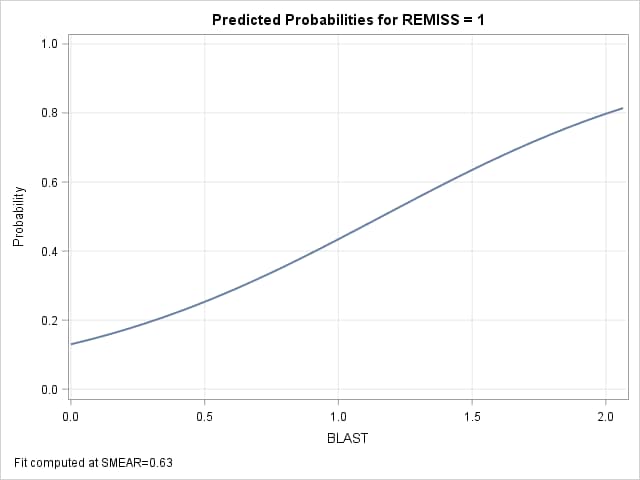   |
The same steps can be used for the probit model.
Marginal effects for higher-order models
As noted above, the marginal effect is the partial derivative of the event probability with respect to the variable of interest, xi:
![]()
For the case of simple main-effects models as discussed above, logit(p)=Σixiβi , the final partial derivative is just βi yielding p(1-p)βi as the marginal effect of xi as before. For a higher-order model, such as a model involving xi in an interaction or quadratic effect, the marginal effect is slightly more complex. Consider the cancer remission data and a model that includes the main effects of BLAST and SMEAR as well as their interaction:
logit(p) = β0 + βsSMEAR + βbBLAST + βsbSMEAR·BLAST
For this model, the partial derivative of x'β with respect to SMEAR is βs+βsbBLAST, so the marginal effect for SMEAR is p(1-p)(βs+βsbBLAST). Similarly for BLAST.
The average marginal effect for BLAST in the above model can be obtained using this call of the Margins macro.
%Margins(data = Remiss,
response = remiss,
roptions = event='1',
model = blast|smear,
dist = binomial,
effect = blast,
options = cl)
For this model with interaction, the average marginal effect of BLAST is estimated to be 0.373 and is significantly different from zero (p=0.0045).
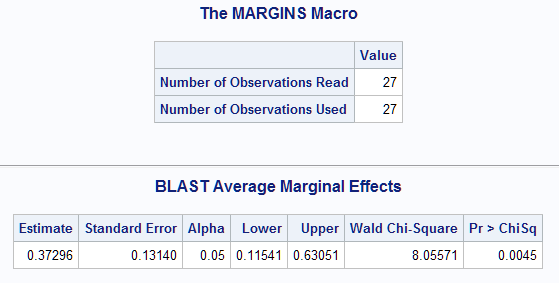 |
Marginal effects for ordinal logistic models
Suppose the possible response values are ordered with levels i=1, 2, ... , k. Under the ordinal logistic model (proportional odds model), the probability of response level i is the difference in the cumulative probabilities at level i and level i-1.
pi = F(αi+x'β) - F(αi-1+x'β) ,
where αi is the ith intercept, β contains all non-intercept parameters, and F(x) is the logistic cumulative distribution function F(x)=exp(x)/(1+exp(x)). Then the marginal effect of the jth predictor, xj, on pi is
![]()
For a model containing only main-effects, ![]() = βj as in the binary logistic model discussed above. For more complex models, replace
= βj as in the binary logistic model discussed above. For more complex models, replace ![]() with the resulting function.
with the resulting function.
The ordinal model can be fit in many procedures including LOGISTIC, PROBIT, GENMOD, GLIMMIX, QLIM, and NLMIXED. However, only PROC QLIM provides an option to compute marginal effect estimates. As for the binary response model, it should only be used to obtain marginal effect estimates for predictors not involved in interactions or higher-order effects in the model.
The following example uses the data from the example titled "Multilevel Response" in the PROC PROBIT documentation. The response is the severity of symptoms with ordered levels: none, mild, severe. These statements create the data set with a numerically coded response variable, Y, with levels 1, 2, and 3 corresponding to increasing severity of the symptoms.
data multi;
input Prep $ Dose Symptoms $ N;
if symptoms='None' then y=1;
else if symptoms='Mild' then y=2;
else y=3;
LDose=log10(Dose);
datalines;
stand 10 None 33
stand 10 Mild 7
stand 10 Severe 10
stand 20 None 17
stand 20 Mild 13
stand 20 Severe 17
stand 30 None 14
stand 30 Mild 3
stand 30 Severe 28
stand 40 None 9
stand 40 Mild 8
stand 40 Severe 32
test 10 None 44
test 10 Mild 6
test 10 Severe 0
test 20 None 32
test 20 Mild 10
test 20 Severe 12
test 30 None 23
test 30 Mild 7
test 30 Severe 21
test 40 None 16
test 40 Mild 6
test 40 Severe 19
;
These statements fit the ordinal logistic model and display the marginal effect estimates. The ordinal probit model can be fit using the DISCRETE(DIST=NORMAL) option. PROC QLIM models the probabilities of higher response levels and cumulates the probabilities over the lower response levels.
proc qlim data=multi;
freq N;
model y=LDose / discrete(dist=logit);
output out=outqlim marginal;
run;
proc print data=outqlim noobs;
where prep='stand';
var y symptoms ldose meff:;
run;
Notice that marginal effect estimates are provided for each response level of the predictor.
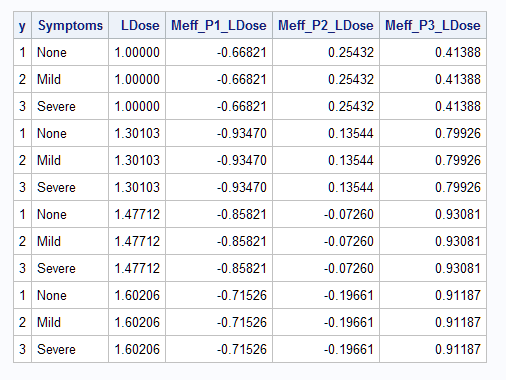 |
Alternatively, you can fit the model in PROC LOGISTIC or PROC PROBIT and compute the marginal effect estimates from the cumulative predicted probabilities. These statements fit the ordinal model, save the parameter estimates and the cumulative predicted probabilities in data sets, and compute the marginal effects. The estimated marginal effects match those from PROC QLIM. The DESCENDING response variable option causes the probabilities at the high end of the response scale to be modeled. The resulting probabilities are cumulated over the response levels 3, 2, and 1 and are named CP_3, CP_2, and CP_1 so that CP_1 = 1. The EFFECTPLOT statement produces a plot of the predicted probabilities for the individual (not cumulative) response levels.
proc logistic data=multi
outest=logparms(rename=(ldose=tldose));
freq N;
model y(descending)=LDose;
effectplot fit(x=ldose) / individual;
output out=outlog predprobs=cumulative;
run;
data margeff;
if _n_=1 then set logparms;
set outlog;
Meff3=(cp_3*(1-cp_3))*tldose;
Meff2=(cp_2*(1-cp_2)-cp_3*(1-cp_3))*tldose;
Meff1=(cp_1*(1-cp_1)-cp_2*(1-cp_2))*tldose;
run;
proc print data=margeff noobs;
where prep='stand';
var y symptoms ldose meff1-meff3;
run;
Examining the plot of the individual probabilities, the slope of a line tangent to the Pr(Y=3) curve is positive and increasingly so as LDose increases. This is reflected in the marginal effects for level 3 (Meff3). Apparently an inflection point is crossed before the highest LDose level resulting in a slight decrease in the marginal effect at that level. The Pr(Y=2) curve has a maximum at about LDose = 1.4 so the slope of a tangent line should be decreasingly positive as LDose increases to that maximum and then be increasingly negative beyond. The marginal effects show this pattern. Finally, the decreasing Pr(Y=1) curve seems to have an inflection point near LDose = 1.3 and the marginal effects show this with an increasingly negative value up to the inflection point and decreasingly negative beyond.
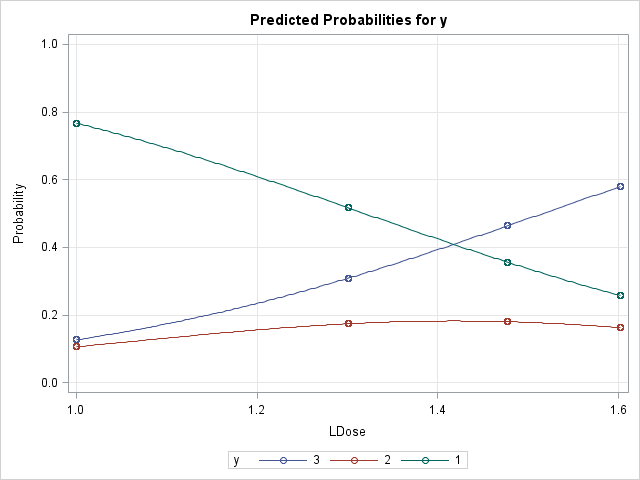 |
The ordinal model can also be fit using PROC NLMIXED as shown in this note, and PREDICT statements can be added to provide an estimate of the marginal effect on the probability of each response level as well as its standard error and a confidence interval.
Marginal effects for nominal multinomial logistic models
Suppose the possible response values are unordered with levels i=1, 2, ... , k. Under the generalized logit model commonly used for nominal responses, the probability of response level i is
pi = exp(x'βi)/Σj(exp(x'βj))
Then the marginal effect of the jth predictor, xj, on pi is
![]()
For a model containing only main-effects, ![]() = βij and
= βij and ![]() = βkj. For more complex models, replace these partial derivatives with the resulting functions.
= βkj. For more complex models, replace these partial derivatives with the resulting functions.
The generalized logit model can be fit by the LOGISTIC, GLIMMIX, CATMOD, and NLMIXED procedures. Marginal effects are not directly available, but can be computed using the parameter estimates and individual predicted probabilities from any of these procedures.
The following example uses the remote-sensing data presented in the example titled "Scoring Data Sets" in the LOGISTIC documentation. The response is the type of crop with five possible levels. X1 is one of four variables used to predict the type of crop. The following statements fit a generalized logit model with X1 as predictor and saves the parameter estimates and individual predicted probabilities to data sets. Marginal effects are computed using the above formula for each of the crops using the values of X1 in each of the observations. Note that four generalized logits can be defined on the five crop types. Consequently, the parameter for the last crop type (Sugarbeets) is constrained to zero. The EFFECTPLOT statement produces a plot of the predicted probabilities for the individual response levels.
proc logistic data=Crops
outest=logparms;
model crop = x1 / link=glogit;
effectplot fit(x=x1) / noobs nolimits;
output out=preds predprobs=individual;
run;
data margeff;
if _n_=1 then set logparms;
set preds;
SumBetaPred=x1_clover*IP_Clover + x1_corn*IP_Corn +
x1_cotton*IP_Cotton + x1_soybeans*IP_Soybeans;
MEClover =IP_Clover*(x1_clover-SumBetaPred);
MECorn =IP_Corn*(x1_corn-SumBetaPred);
MECotton =IP_Cotton*(x1_cotton-SumBetaPred);
MESoybeans =IP_Soybeans*(x1_soybeans-SumBetaPred);
MESugarbeets=IP_Sugarbeets*(-SumBetaPred);
run;
proc sort nodupkey;
by x1;
run;
proc print;
id x1;
var ME:;
run;
The values of the marginal effects reflect the slopes of lines tangent to each of the crop curves at each X1 setting. For instance, lines tangent to the Soybeans curve have positive slopes up to about 19, then become negative after 20, and essentially zero beyond 50.
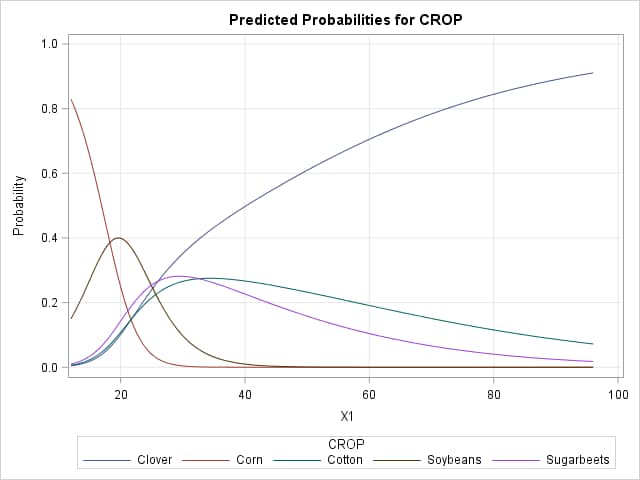 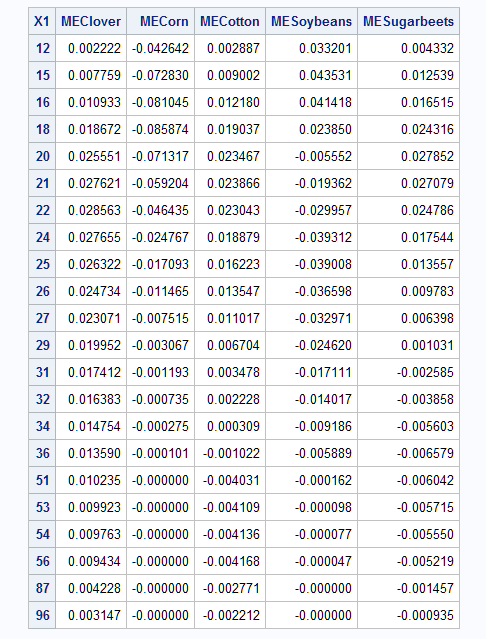 |
Again, the model could be fit in PROC NLMIXED including PREDICT statements to estimate the marginal effects and provide confidence limits.
References
Operating System and Release Information
| Product Family | Product | System | SAS Release | |
| Reported | Fixed* | |||
| SAS System | SAS/STAT | All | n/a | |
| Type: | Usage Note |
| Priority: | low |
| Topic: | SAS Reference ==> Procedures ==> PROBIT Analytics ==> Regression SAS Reference ==> Procedures ==> LOGISTIC SAS Reference ==> Procedures ==> QLIM Analytics ==> Econometrics Analytics ==> Categorical Data Analysis SAS Reference ==> Procedures ==> NLMIXED SAS Reference ==> Macro |
| Date Modified: | 2019-04-12 10:08:05 |
| Date Created: | 2002-12-16 10:56:39 |